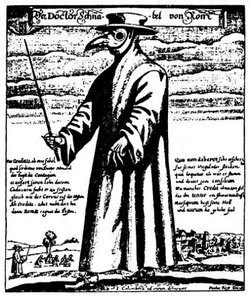Take a
look at the picture (below). I like to start some of my classes with an
impossible task such as working out what these series of squiggles is all
about. Surprisingly, if my pupils are given the topic they can come very close
to guessing what these mystery pictures are all about. This particular medieval
drawing is the beginning of a study of the Black Death.
Can you
work out what it is? Pause for wild
guesswork
The
picture actually shows graffiti from the Middle Ages and gives a fascinating
look into what people might have been thinking as the Black Death swept across
Europe between 1348-51. The meaning
is "A wretched, terrible, destructive year. The remnants of the people alone remain". It's taken from a medieval church in Hertfordshire where almost
the entire population died. We can only guess what happened to the author.
Few
events in history have affected Britain as much as the Black Death. Beyond
showing awful pictures and descriptions of people dying grisly deaths, (making
my year 7s go ewwww) I teach it because it changed the world.
 To those of you who
love the great men, women and battles of the past, the idea that a small
bacteria (Yersinia pestis)
could change the world more than William the Conqueror or Elizabeth I just
seems unthinkable. Despite its apparent insignificance, it left over a third of
the population of Europe dead, killed rich and poor indiscriminately and made
many people think that the end of humanity had really come. Imagine living in a world
where people were dying quicker than others could bury them, where ordinary
life seemed to fall apart and where no-one seemed to know how to stop the
spread.
To those of you who
love the great men, women and battles of the past, the idea that a small
bacteria (Yersinia pestis)
could change the world more than William the Conqueror or Elizabeth I just
seems unthinkable. Despite its apparent insignificance, it left over a third of
the population of Europe dead, killed rich and poor indiscriminately and made
many people think that the end of humanity had really come. Imagine living in a world
where people were dying quicker than others could bury them, where ordinary
life seemed to fall apart and where no-one seemed to know how to stop the
spread.
The desperation must
have been awful, not to mention the psychological trauma suffered by an entire
generation. In truth, it's impossible to fully appreciate that situation but by
trying, you can get a fascinating glimpse into the world
of our medieval graffiti artist.
You can
probably also understand the wild range of cures which abounded in this period.
"Toads should be thoroughly dried in the sun. They should be placed on the plague boil. The toad will swell and draw out the poison of the plague to its own body. When it is full it should be thrown away and a new one applied" Guy de Chauillac
People were so
desperate to get some kind of control back over their lives (and impending
deaths) that they would go to incredible lengths to find a solution. On the
face of it, many of these cures seem stupid but remember they were formed in a
world without penicillin and scientific medicine. I can't help thinking how sad
it is that a small batch of antibiotics could have wiped the entire thing out.
 |
| A flea which has been infected with the Black Death Pathogen |
Eventually,
the Black Death receded (wiped out partly because it killed it's victims too
quickly) and people returned to their lives. Indeed, this is one of the most
engaging parts of the story. How can life ever be normal after an event like
this?
In short,
it wasn't "normal" ever again. There were a whole host of consequences. One example might suffice. Surviving peasants quickly realised
that their services were now at a premium (given the deaths of many of their peers) and they could start to demand certain
rights from those who had oppressed them for centuries. The Black Death
effectively ended the Feudal System, loosened the grip of the powerful
landlords and caused an otherwise impossible wave of demands for workers' rights. It turned
society on its head. Not bad for a small piece of bacteria which can't be seen
without a microscope!
Despite
our own good grip of medicine and science, this makes me think. Many people
look to China, The Middle East or India for the next event to change our world.
There are good arguments for each of these places being the next champion of
change. But maybe, (and this might be one for my science friends) our next
revolutionary world changer is sitting in a petri dish waiting
to be identified as our next wave of H1N1 flu or an otherwise harmless virus
just waiting to mutate (cue X Men theme tune)...

